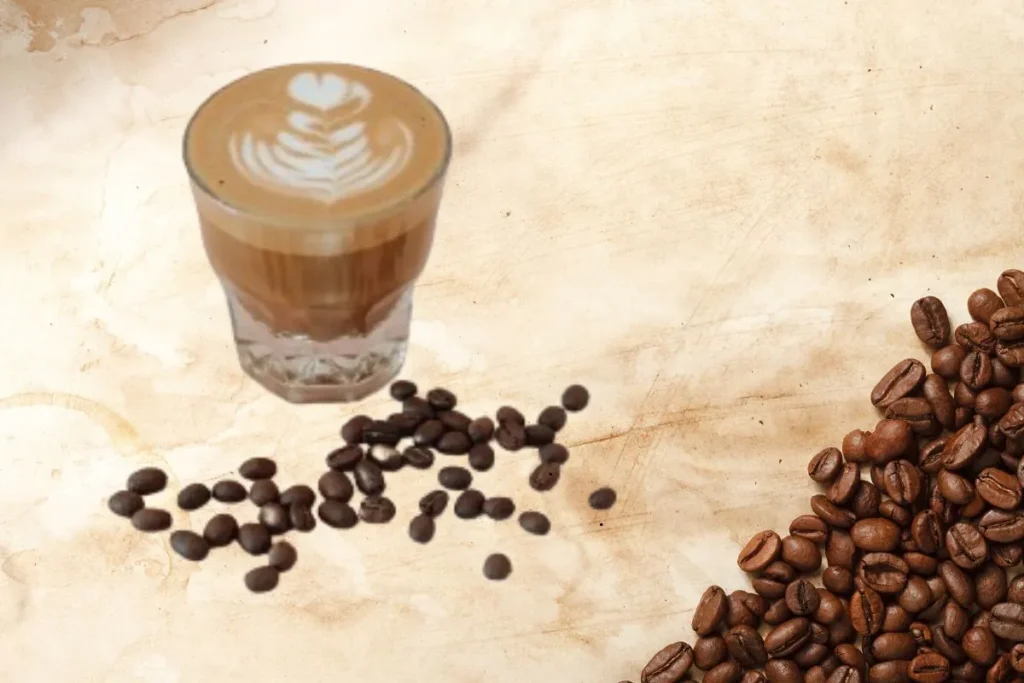Gibraltar Coffee is a delicious espresso-based drink that combines the smooth, creamy texture of steamed milk with the robust, rich flavors of espresso. It takes its name from the Gibraltar glass, a little, tapering glass that is typically used to serve this beverage. Gibraltar Coffee is a favorite among coffee lovers because of the delicious balance and small serving size.
What is Gibraltar Coffee
Gibraltar coffee, a unique espresso-based beverage, has captured the hearts of coffee enthusiasts since its creation at the renowned Blue Bottle Coffee Company in San Francisco. This delightful drink showcases a harmonious blend of equal parts espresso and steamed milk, resulting in a perfectly balanced flavor profile that satisfies both the bold coffee lover and those who appreciate a touch of creamy sweetness.
What sets Gibraltar Coffee Recipe apart is its specific composition and serving style. Baristas skillfully pull a double shot of espresso, typically measuring 2 ounces, and combine it with an equal amount of expertly steamed milk. The milk is heated to a precise temperature range of 150-160°F, creating a smooth and velvety consistency without the excessive foam often found in cappuccinos or lattes.
One of the most distinctive aspects of Gibraltar coffee is its presentation in the iconic Gibraltar glass. These 4.5-ounce, ridged glasses feature a tapered bottom, providing not only a visually appealing aesthetic but also contributing to the drink’s unique identity.
The compact size of the Gibraltar glass perfectly accommodates the equal parts of espresso and milk, ensuring a consistent and enjoyable experience with every sip.
Gibraltar coffee is celebrated for its well-rounded flavor profile, striking a delightful balance between the rich, bold notes of espresso and the smooth, creamy texture of steamed milk. The equal proportions of these two key ingredients create a drink that is neither overpoweringly strong nor cloyingly sweet, making it an ideal choice for coffee lovers who appreciate nuance and complexity in their beverages.
While Gibraltar coffee shares similarities with other espresso-based drinks, such as the cortado and flat white, it maintains its own distinct identity. Cortados, which also feature equal parts espresso and milk, are typically served in smaller volumes and often lack the signature Gibraltar glass.
Flat whites, originating from Australia and New Zealand, are characterized by their microfoam steamed milk but are usually served in larger ceramic cups.
The popularity of Gibraltar coffee has steadily grown beyond its San Francisco origins, with specialty coffee shops around the world embracing this delightful beverage. Its appeal lies not only in its balanced flavor profile but also in the craftsmanship and attention to detail required to create the perfect cup.
Baristas take pride in mastering the art of pulling the ideal espresso shot and steaming the milk to the optimal consistency, ensuring a consistently exceptional experience for their customers.
Key Characteristics of Gibraltar Coffee
Gibraltar coffee boasts several distinguishing characteristics that set it apart from other espresso-based beverages. These key features contribute to its unique identity and the growing popularity it enjoys among coffee enthusiasts.
Equal Parts Espresso and Steamed Milk
One of the defining aspects of Gibraltar coffee is its composition, which consists of equal parts espresso and steamed milk. Typically, a double shot of espresso, measuring around 2 ounces, is combined with an equivalent amount of expertly steamed milk.
This balanced ratio creates a harmonious flavor profile, allowing the bold notes of the espresso to shine through while being complemented by the smooth and creamy texture of the milk.
Velvety Milk Consistency
Unlike lattes or cappuccinos, which often feature a substantial layer of foam, Gibraltar coffee is characterized by its velvety milk consistency. Baristas skillfully steam the milk to a temperature between 150-160°F, resulting in a smooth and silky texture with minimal foam.
This technique enhances the overall mouthfeel of the drink, providing a luxurious and satisfying experience with each sip.
Served in a Distinctive Gibraltar Glass
Another key characteristic of Gibraltar coffee is its presentation in the iconic Gibraltar glass. These 4.5-ounce glasses feature a unique ridged design and a tapered bottom, adding to the drink’s visual appeal and distinct identity.
The compact size of the Gibraltar glass perfectly accommodates the equal proportions of espresso and milk, ensuring a consistent and enjoyable experience from the first sip to the last.
Balanced Flavor Profile
Gibraltar coffee is renowned for its well-rounded and balanced flavor profile. The equal parts of espresso and steamed milk create a perfect harmony, allowing the rich and complex notes of the espresso to be complemented by the subtle sweetness and creaminess of the milk.
This balance makes Gibraltar coffee an attractive choice for those who appreciate a strong coffee flavor without the overpowering intensity of a straight espresso shot.
Craftsmanship and Attention to Detail
Creating the perfect Gibraltar coffee requires a high level of skill and attention to detail from the barista. From grinding and tamping the espresso to steaming the milk to the ideal consistency, each step of the process demands precision and expertise.
The resulting drink is a testament to the barista’s craftsmanship and dedication to delivering an exceptional coffee experience to their customers.
How to Make Gibraltar Coffee: Step-by-Step

Crafting the perfect Gibraltar coffee at home or in a café setting requires a combination of quality ingredients, the right equipment, and a step-by-step approach to ensure a delightful and consistent result. Follow this detailed guide to create your own Gibraltar coffee:
Ingredients Needed
- Freshly roasted espresso beans
- Whole milk (or your preferred alternative milk)
Equipment Needed
- Espresso machine with a steam wand
- Espresso grinder
- Portafilter and tamper
- Milk steaming pitcher
- Gibraltar glasses
Recipe
Step 1: Prepare the Espresso
- Begin by grinding your freshly roasted espresso beans to a fine consistency suitable for your espresso machine.
- Dose the ground coffee (typically 18-21 grams) into the portafilter and tamp it evenly to create a level surface.
- Purge the group head of your espresso machine and lock in the portafilter.
- Start the extraction process, aiming for a 25-30 second pull to obtain a double shot of espresso (approximately 2 ounces).
Step 2: Steam the Milk
- While the espresso is extracting, pour cold whole milk into your steaming pitcher, filling it about 1/3 to 1/2 full.
- Purge the steam wand and place the tip just below the surface of the milk at a slight angle.
- Open the steam valve and start incorporating air into the milk by creating a gentle whirlpool motion. Keep the tip near the surface for about 5 seconds to introduce just enough foam.
- Submerge the steam wand deeper into the milk and continue steaming until it reaches a temperature between 150-160°F (65-70°C). Use a thermometer to ensure accuracy.
- Close the steam valve, remove the pitcher, and give it a gentle tap on the counter to disperse any large bubbles. Swirl the pitcher to create a smooth and glossy texture.
Step 3: Combine the Espresso and Milk
- Preheat your Gibraltar glass by running it under hot water or filling it with boiling water for a few seconds. Empty and dry the glass thoroughly.
- Pour the freshly pulled double shot of espresso into the preheated Gibraltar glass.
- Gently pour the steamed milk over the espresso, starting from a low height and gradually raising the pitcher. Aim to create a smooth and well-integrated blend of espresso and milk.
- Optional: If desired, you can create simple latte art by carefully pouring the last bit of steamed milk in a pattern on top of the drink.
Step 4: Serve and Enjoy
- Serve your Gibraltar coffee immediately to ensure the best flavor and temperature.
- Enjoy the balanced and creamy taste of your perfectly crafted Gibraltar coffee.
Tips for Perfecting Your Gibraltar Coffee
While the basic steps for making a Gibraltar coffee are straightforward, there are several tips and techniques that can help you elevate your craft and create an exceptional drinking experience. Here are some valuable insights to keep in mind as you strive to perfect your Gibraltar coffee:
1. Use Freshly Ground, High-Quality Espresso Beans
The foundation of a great Gibraltar coffee lies in the quality of the espresso. Invest in freshly roasted, high-quality espresso beans and grind them just before brewing to ensure optimal flavor and aroma. Experiment with different bean origins, roast levels, and blends to find the perfect match for your taste preferences.
2. Ensure Proper Espresso Extraction
A well-extracted espresso shot is crucial to the overall balance and flavor of your Gibraltar coffee. Aim for a 25-30 second extraction time, which typically yields a double shot of espresso (around 2 ounces). Pay attention to the color, consistency, and flow of the espresso as it pours, making adjustments to the grind size or tamping pressure if needed to achieve the desired result.
3. Master the Milk Steaming Technique
Steaming the milk to the perfect consistency and temperature is an art that requires practice. Focus on creating a smooth, velvety texture with minimal foam, as this is a defining characteristic of Gibraltar coffee.
Keep the steam wand just below the surface of the milk initially to incorporate a small amount of air, then submerge it deeper to create a whirlpool motion and heat the milk evenly. Aim for a final temperature between 150-160°F (65-70°C) for optimal flavor and mouthfeel.
4. Preheat Your Gibraltar Glass
Preheating your Gibraltar glass helps maintain the ideal temperature and consistency of your drink. Fill the glass with hot water or run it under a hot water tap for a few seconds before emptying and drying it thoroughly.
This simple step ensures that your espresso and steamed milk maintain their desired temperature and flavors as you combine them.
5. Practice Pouring Technique
Developing a smooth and controlled pouring technique is essential for creating a well-integrated Gibraltar coffee. Start by pouring the steamed milk slowly and steadily into the center of the espresso, gradually raising the pitcher as you go.
This method helps to evenly distribute the milk and create a harmonious blend of flavors. With practice, you can even attempt simple latte art designs to add a touch of visual appeal to your drink.
6. Experiment with Milk Alternatives
While whole milk is the traditional choice for Gibraltar coffee, don’t be afraid to experiment with alternative milk options to cater to dietary preferences or explore new flavor profiles.
Oat milk, almond milk, and soy milk are popular alternatives that can provide a delicious twist on the classic recipe. Keep in mind that each milk variety may require slight adjustments in steaming technique to achieve the desired consistency.
7. Clean and Maintain Your Equipment
Regular cleaning and maintenance of your espresso machine, grinder, and milk steaming equipment are essential for producing high-quality Gibraltar coffees consistently.
Ensure that you purge the steam wand before and after each use, wiping it clean with a damp cloth. Regularly backflush your espresso machine and descale it according to the manufacturer’s recommendations to keep it in top condition.
Troubleshooting Common Issues
Crafting the perfect Gibraltar coffee requires precision and attention to detail. When troubleshooting common issues, it’s essential to consider every step of the process, from bean selection to final presentation.
Espresso Quality Concerns
If your espresso tastes bitter, it’s likely due to over-extraction. This can occur when water passes through the grounds for too long, pulling out harsh compounds. To remedy this, try adjusting your grind size slightly coarser or reducing the extraction time.
Conversely, sour espresso often results from under-extraction. In this case, a finer grind or longer extraction time may help. Always ensure your portafilter is evenly tamped to promote uniform water flow through the coffee bed.
Milk Steaming Challenges
Achieving the ideal milk texture for Gibraltar coffee can be tricky. Unlike lattes or cappuccinos, Gibraltar requires less aeration. Begin by purging the steam wand to remove any condensation. Submerge the wand just below the milk’s surface and create a gentle whirlpool effect.
Aim for minimal foam – just enough to create a silky microfoam. If you’re getting large bubbles, you’re likely introducing too much air. Focus on keeping the wand tip just under the milk’s surface for a brief 3-4 seconds before submerging it deeper.
Temperature Control
Milk scalding is a common pitfall. It not only affects taste but can also lead to an unpleasant mouthfeel. Use a thermometer until you develop a keen sense for proper temperature. The sweet spot for milk in Gibraltar coffee lies between 150-160°F (65-71°C). At this range, natural sugars in the milk are enhanced without burning off, complementing the espresso’s flavors.
Ratio and Integration
The hallmark of Gibraltar coffee is its perfect balance of espresso and milk. Stick to the standard 1:1 ratio, typically using 2 ounces each of espresso and steamed milk.
When combining the two elements, pour the milk gently over the espresso. This allows for proper integration without creating distinct layers. If you notice separation, it’s often due to pouring technique or temperature differences between the espresso and milk.
Glassware Considerations
The iconic Gibraltar glass plays a crucial role in the drink’s presentation and temperature retention. A common mistake is serving in a cold glass, which can quickly cool the beverage.
Preheat your Gibraltar glass by filling it with hot water while preparing the espresso. Discard the water just before assembling your drink. This simple step ensures your coffee stays at an optimal temperature throughout the drinking experience.
Gibraltar Coffee Customization Options
One of the beauties of Gibraltar coffee is its versatility, allowing for a range of customization options to suit individual tastes and preferences. By making simple adjustments to the recipe or ingredients, you can create a personalized Gibraltar coffee experience that truly resonates with your palate.
Adjusting the Espresso to Milk Ratio
While the traditional Gibraltar coffee recipe calls for equal parts espresso and steamed milk, you can easily customize the ratio to your liking. If you prefer a stronger, more espresso-forward flavor, consider increasing the amount of espresso while slightly reducing the milk.
Conversely, if you enjoy a creamier, more balanced taste, you can opt for a higher proportion of steamed milk to espresso. Experimenting with different ratios will help you find the perfect balance that suits your taste buds.
Exploring Milk Alternatives
For those with dietary restrictions or those looking to venture beyond traditional dairy milk, Gibraltar coffee can be made with a variety of milk alternatives. Oat milk has gained popularity in recent years due to its creamy texture and subtle sweetness, making it an excellent choice for Gibraltar coffee.
Almond milk and soy milk are other common alternatives that can add unique flavor dimensions to your drink. When using non-dairy milk, be sure to adjust your steaming technique accordingly, as each type of milk may behave differently when heated and frothed.
Incorporating Flavored Syrups
While the classic Gibraltar coffee is delicious on its own, you can add a touch of sweetness and flavor by incorporating syrups into your drink. Popular syrup options include vanilla, caramel, and hazelnut, which can complement the rich, bold notes of the espresso.
Start with a small amount of syrup (about 1/2 to 1 ounce) and adjust to your taste preferences. Be mindful not to overpower the inherent flavors of the espresso and milk, as the goal is to enhance rather than mask them.
Experimenting with Espresso Blends and Single Origins
The type of espresso beans you use can significantly impact the flavor profile of your Gibraltar coffee. Experiment with different espresso blends and single-origin beans to discover a wide range of tastes and aromas.
Some blends may offer a balanced, well-rounded flavor, while others may highlight specific tasting notes such as chocolate, nuts, or fruit. Single-origin espressos can showcase the unique characteristics of a particular coffee-growing region, adding depth and complexity to your Gibraltar coffee.
Iced Gibraltar Coffee
For a refreshing twist on the classic Gibraltar coffee, try making an iced version. Pull your espresso shot directly over ice in a chilled Gibraltar glass, then pour the chilled, lightly frothed milk over the top.
This method creates a cool and invigorating drink that’s perfect for hot summer days. You can also experiment with cold brew concentrate or espresso for an even smoother, less acidic iced Gibraltar coffee experience.
Seasonal and Holiday-Inspired Variations
Get creative with your Gibraltar coffee by incorporating seasonal flavors and holiday-inspired twists. During the autumn months, try adding a touch of pumpkin spice syrup or a sprinkle of cinnamon on top of your drink.
For the winter holidays, consider infusing your Gibraltar coffee with gingerbread, peppermint, or eggnog flavors. These seasonal variations can add a festive and comforting touch to your daily coffee routine.
Conclusion: Gibraltar Coffee Recipe
Gibraltar Coffee is a delightful espresso-based drink that strikes the perfect balance between rich espresso and creamy steamed milk. Its unique serving style in the Gibraltar glass and its harmonious flavor profile make it a favorite among coffee aficionados. Whether you want it flavored or unflavored, hot or iced, Gibraltar Coffee will make your day.
Frequently Asked Questions
Q1: What distinguishes Gibraltar coffee from other espresso drinks?
Gibraltar coffee features a 1:1 ratio of espresso to steamed milk, served in a distinctive 4.5 oz rock glass. Its balanced flavor profile and minimal foam set it apart from lattes or cappuccinos. The drink’s compact size and robust taste make it a favorite among coffee enthusiasts seeking a refined espresso experience.
Q2: Can I make Gibraltar coffee without an espresso machine?
While an espresso machine is ideal, you can approximate the flavor using a Moka pot or AeroPress for strong coffee. Steam milk using a handheld frother or heat it gently on the stovetop. Although the result may not be identical, this method can still produce a satisfying alternative for home brewers without access to professional equipment.
Q3: What’s the optimal milk temperature for Gibraltar coffee?
Aim for 150-160°F (65-71°C). This range enhances milk’s natural sweetness without scalding, complementing the espresso perfectly. Achieving this precise temperature ensures a smooth, velvety texture and helps maintain the delicate balance between coffee and milk flavors.
Q4: Is Gibraltar coffee stronger than a latte?
Yes, Gibraltar coffee contains a higher coffee-to-milk ratio than a typical latte, resulting in a more intense flavor and slightly higher caffeine content. This concentration allows the nuanced notes of the espresso to shine through, offering a bolder coffee experience in a smaller serving size.
Q5: Why is it called ‘Gibraltar’ coffee?
The name originates from the Libbey Gibraltar glass in which it’s traditionally served, first popularized by Blue Bottle Coffee in San Francisco. This unique glassware choice became so synonymous with the drink that it eventually lent its name to the beverage itself, highlighting the importance of presentation in specialty coffee culture.

Rossi Glover, the passionate Owner of Grand Lake Coffee, infuses every cup with her love for coffee and dedication to quality. With an extensive background in the art and science of coffee, Rossi is not just a connoisseur but a storyteller, sharing the intricate tales behind each brew.

